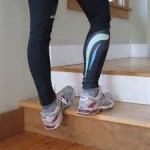Stretch!
If you’re on your feet all day, try this simple Calf Stretch to ease sore feet.
Use a step or a curb, or on any stable platform that is about two inches off the floor. Place your right foot flat on the step, hold on for balance. Place the ball of your left foot on the step with your heel hanging off. Slowly drop your left heel, feeling a gentle stretch in the left calf. Hold for ten to thirty seconds. Release the stretch. Repeat with your left foot flat on the step and your right heel hanging off.
*Always consult your physician before beginning exercise.
 Subscribe
Subscribe



